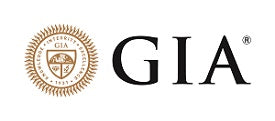GIA, EGL USA, AGS - Diamond Grading Labs
Certified diamonds are backed up by ratings from trusted researchers, and the most common include EGL USA, GIA, and AGS. These certifications use different scales and laboratory methods, but all ratings value a diamond's cut, clarity, color, and carats.
GIA Certified Diamonds
 The Gemological Institute of America (GIA), a nonprofit research institution, certifies each diamond by authenticating a few characteristics that are absolutely vital to its overall value. Their ratings hold a lot of weight because of their long history of scientific dedication; they're always perfecting ways to identify different types of diamonds and determine their history, chemical composition, carats, spectral features, and more. They can rate both natural and synthetic diamonds, as well as treated and colored diamonds.
The Gemological Institute of America (GIA), a nonprofit research institution, certifies each diamond by authenticating a few characteristics that are absolutely vital to its overall value. Their ratings hold a lot of weight because of their long history of scientific dedication; they're always perfecting ways to identify different types of diamonds and determine their history, chemical composition, carats, spectral features, and more. They can rate both natural and synthetic diamonds, as well as treated and colored diamonds.
GIA also created the International Diamond Grading System, their exclusive method for describing colored diamonds and evaluating all diamonds. Their researchers work on millions of gemstones each year, and they've been trusted to assess everything from the 45-carat Hope diamond to the record-breaking, 407-carat Incomparable Diamond.
GIA diamond grading reports revolve around the "4 Cs": color, carat weight, cut, and clarity. While they invented this particular criteria, all ratings now address these four essential characteristics. The GIA color scale begins at the letter D and ends at Z, and each letter represents a different hue. This subtle distinction can heavily impact the diamond's value, because it's a highly objective way to assess a diamond's purity. A "D" diamond is virtually colorless, with structural and chemical integrity, but most treated diamonds fall much farther down the line.
EGL USA Certified Diamonds
 Two American labs are responsible for maintaining the standards of science and service associated with the European Gemological Laboratory (EGL). In New York and Los Angeles, EGL USA experts offer evaluations and treatments for customers' diamonds and gemstones, and their researchers conduct careful lab analysis and issue industry-leading reports about diamonds.
Two American labs are responsible for maintaining the standards of science and service associated with the European Gemological Laboratory (EGL). In New York and Los Angeles, EGL USA experts offer evaluations and treatments for customers' diamonds and gemstones, and their researchers conduct careful lab analysis and issue industry-leading reports about diamonds.
EGL is a for-profit organization, so it doesn't always receive equal respect among jewelers and collectors as its counterparts, GIA and AGS. However, EGL emphasizes customer service and accessibility, so it's the best choice for the average consumer who wants to get a diamond certified, even if the reports don't synchronize completely with those higher-brow ratings. EGL makes it easier to afford, receive, and understand the comprehensive report that comes with each certification, too.
AGS Certified Diamonds
 The American Gem Society (AGS) implements a diamond grading system that measures cut, color, and clarity, in that order. These values are always numbers that fall between 0 and 10. Unlike other institutions that identify diamonds as "flawless" or "colorless", AGS researchers can place each diamond on a very specific numeric scale to explain its exact quality. These ratings can be combined with the carat weight; for example, a diamond rated "5/4.5/2-4.000
The American Gem Society (AGS) implements a diamond grading system that measures cut, color, and clarity, in that order. These values are always numbers that fall between 0 and 10. Unlike other institutions that identify diamonds as "flawless" or "colorless", AGS researchers can place each diamond on a very specific numeric scale to explain its exact quality. These ratings can be combined with the carat weight; for example, a diamond rated "5/4.5/2-4.000
carat" would be a four-carat, slightly included, faintly colored diamond with a very good cut.
According to the the AGS standards, a "triple zero" diamond is as good as it gets, but any diamond with a color or clarity rating below 3 is very close to ideal. The trade association has existed since 1934, and today its laboratories' findings are still trusted by consumers, retailers, and auctioneers alike. They even offer micro laser inscription, which marks a diamond's serial number, brand, and other information for the ultimate authentication.

